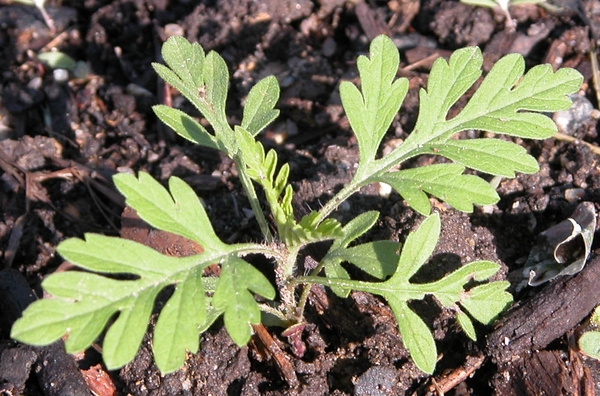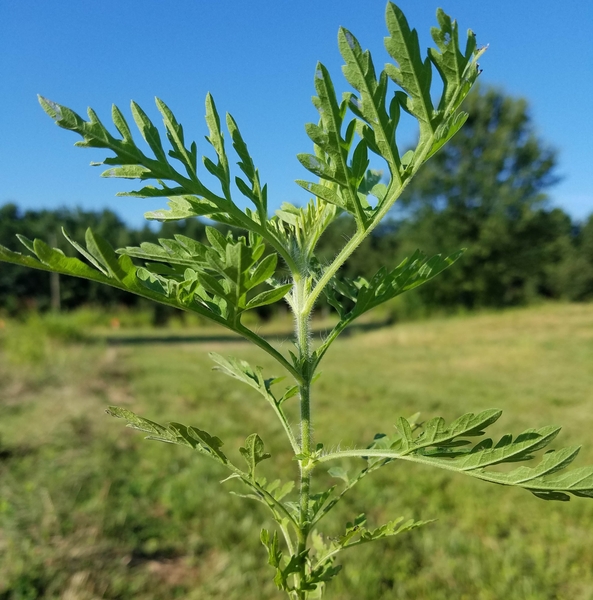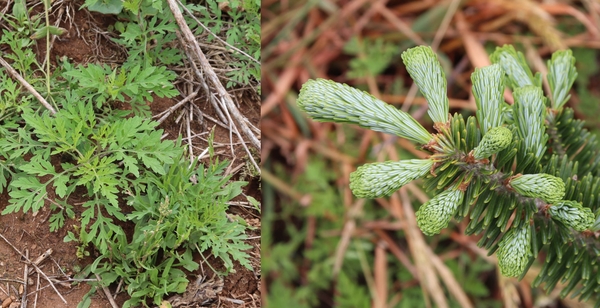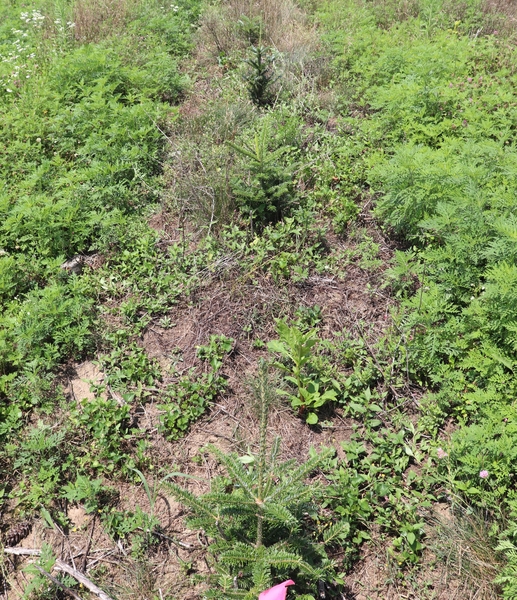Common ragweed (Ambrosia artemisiifolia) is common in most cropping systems. Control strategies in most crops include a combination of preemergence and postemergence herbicides as well as cultivation and mulches. Yet, herbicide-resistant populations have made this weed more challenging to control, and it has become particularly problematic in NC Fraser fir Christmas tree fields, In NC Fraser fir production, growers have typically relied solely on postemergent herbicides as a way to maintain ground cover to protect soil on steep mountain fields. Currently, growers have few herbicide options that control a broad spectrum of weeds AND ragweed. For those IPM growers who manage white clover ground covers, remaining labeled postemergence control options will also damage their intended cover crop.
About Ragweed
Common ragweed is a summer annual that germinates in mid-to-late spring, (starting several weeks after lambsquarters) and continues to emerge through the summer (Figure 1). Ragweed seedlings have opposite, lobed leaves (Figure 2). As the plant matures, the leaves become sub-opposite to alternate and the lobes deepen (Figure 3). Mature leaves will be dissected (deep lobes will in turn be lobed). At maturity, the plants can grow 4 to 5 feet tall, shading the lower branches of Fraser fir or completely overtopping young trees. The erect stems also interfere with tree shearing operations.
Ragweed Control
Ragweed is controlled by several preemergence herbicides including flumioxazin (Sureguard) and simazine (Princep, Simazine, others). However, regular use of these herbicides results in extensive bare ground which leads to soil erosion. Other preemergence herbicides that are less injurious to clover and other desirable ground covers have been ineffective on ragweed. These other products may still be useful for the control of other annual weeds such as horseweed, lambsquarters, or foxtails – but not ragweed.
Ragweed may also be controlled postemergence but the labeled herbicides either lack safety to Fraser fir when applied after budbreak, or injure clover ground cover. Fraser fir trees usually break bud before ragweed emerges (Figure 4). This complicates postemergence control efforts because the herbicides currently labeled for ragweed control in Fraser fir fields, will also kill the desirable ground cover (such as white clover). See Table 1. Growers who need to control ragweed will be confronted with difficult decisions. Use directed applications to avoid contact with Fraser fir trees or use safer products undirected that will kill the clover. Directed applications work best early when weeds are still small and spray can be applied below Christmas tree branches.
Table 1. Postemergence herbicide efficacy and crop safety rankings based on NCSU Research and label guidelines.
Color codes are analogous to street lights where green means “go,” yellow indicates “caution,” and red(ish) means “stop.” We want ‘green’ across all columns. Yellow indicates the treatment may be effective or safe enough for use. Red indicates the treatment is ineffective on ragweed or causes excessive injury to either Fraser fir or to clover.
| Herbicide | Mode of Action | Ragweed control |
Safety to Fraser fir (post bud break) |
Safety to White Clover |
|---|---|---|---|---|
| Labeled options | ||||
|
Glyphosate (many trade names) |
EPSP inhibitor |
Poor to fair* |
Good |
Good |
|
Clopyralid (Stinger, Lontrel, Transline, CleanSlate, & others) |
Synthetic auxin |
Good |
Good |
Poor |
|
2,4-D amine (Weedar 64, and others) |
Synthetic auxin. |
Good |
Poor |
Good to Fair |
|
Bentazon (Basagran) |
PS II inhibitor |
Poor |
Fair |
Good |
|
Oxyfluorfen (Goal & others) |
PPO inhibitor |
Poor |
Poor early, good after 3 in. growth |
Fair
|
|
Flumioxazin (Sureguard) |
PPO inhibitor |
Fair to Good |
Poor |
Fair |
|
Topramazone (Frequency) |
HPPD inhibitor |
Good |
Fair to Good |
Poor |
| Research results: | ||||
|
Cloransulam (FirstRate) |
ALS inhibitor |
Fair (in combination with glyphosate) |
Fair to Good |
Fair to Good |
|
Thifensulfuron (Harmony) |
ALS inhibitor |
Poor |
Fair to Good |
Fair to Good |
|
Saflufenacil (Detail & others) |
PPO inhibitor |
Good |
Poor |
Poor |
|
Florpyrauxifen (Rinskor) |
Synthetic auxin |
Good |
Poor |
Poor |
*Poorer control where glyphosate resistance is present. At vegetation suppression rates;
Summer postemergence ragweed control:
Late spring and summer weed problems depend on postemergence control. Ultimately, what is the bottom line for postemergence ragweed control?
For growers who are trying to maintain clover cover:
- Spot treat ragweed seedlings with 2,4-D amine. These applications must avoid contact with the new growth on Fraser fir or significant injury will result (Figure 5).
- Flumioxazin controls seedling ragweed and prevents late season emergence; Applications before bud break do not injure Fraser fir, but applications after bud break have caused severe injury to the new growth. Clover will be damaged but usually recovers.
If you are not trying to maintain clover (or are willing to kill the clover to control ragweed):
- Clopyralid is safe for applications in Fraser fir fields before or after budbreak (directed sprays avoiding tree leaders are still recommended). Clopyralid will kill clover (even with a complete over-story of ragweed). Also, clopyralid is persistent in the soil and may interfere with re-establishment of clover
- Topramazone may be used as a directed spray in Fraser fir for ragweed control (Figure 6). Applications contacting the trees after bud break may cause yellow growing points but plants do grow out of this injury. Topramzaone is more effective when applied to young seedling ragweed.
Preemergent control for next year.
If you have a heavy infestation of ragweed in the fields this year, rest assured it will be back again next year. Preemerence herbicides are somewhat effective in controlling ragweed. Flumioxazin, oxyfluorfen, or indaziflam (Esplanade, Marengo) applied in early spring before bud break have reduced but not eliminated ragweed populations.
The Future
We are continuing to evaluate control options for ragweed control in NC Fraser fir production and to work with the USDA IR-4 program and manufacturers to generate the data needed to obtain product registrations.
This research was supported by the NC Christmas Tree Association, the national Real Christmas Tree Board, and the USDA IR-4 Environmental Horticulture Program.
Publication date: July 29, 2022
Recommendations for the use of agricultural chemicals are included in this publication as a convenience to the reader. The use of brand names and any mention or listing of commercial products or services in this publication does not imply endorsement by NC State University or N.C. A&T State University nor discrimination against similar products or services not mentioned. Individuals who use agricultural chemicals are responsible for ensuring that the intended use complies with current regulations and conforms to the product label. Be sure to obtain current information about usage regulations and examine a current product label before applying any chemical. For assistance, contact your local N.C. Cooperative Extension county center.
N.C. Cooperative Extension prohibits discrimination and harassment regardless of age, color, disability, family and marital status, gender identity, national origin, political beliefs, race, religion, sex (including pregnancy), sexual orientation and veteran status.






